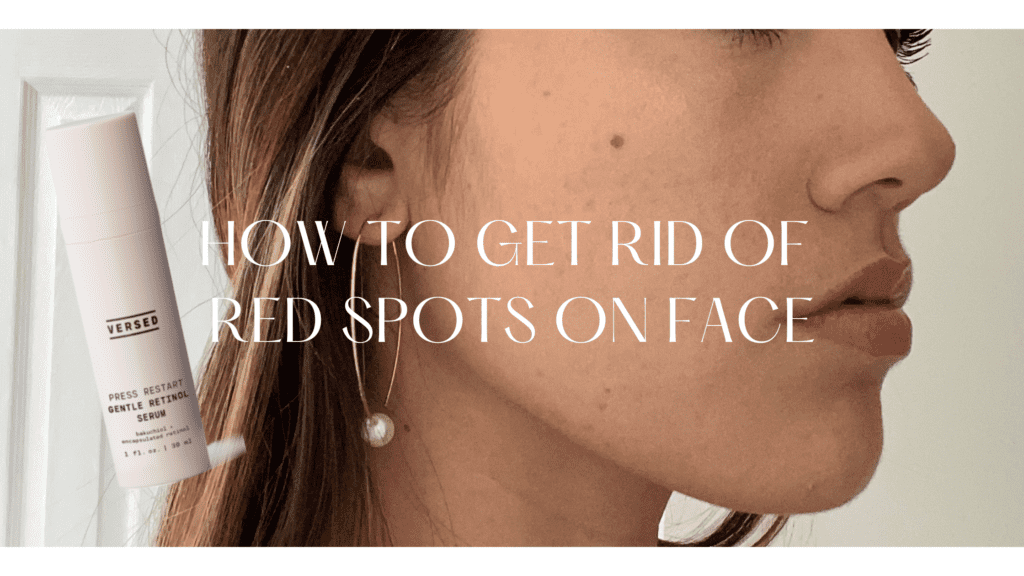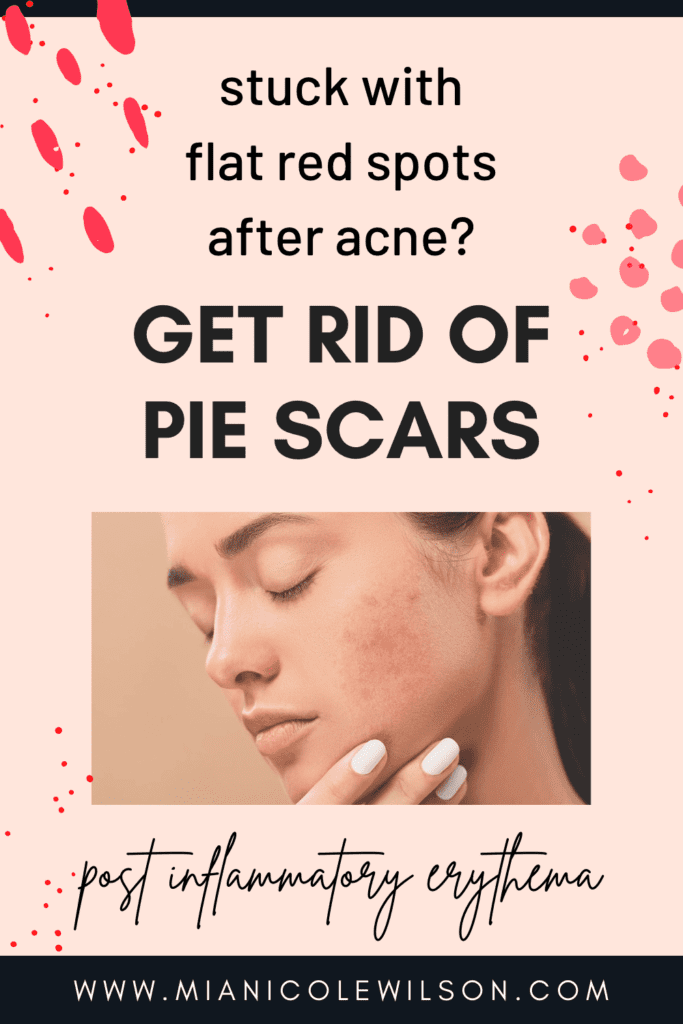Do you have red spots on your face that are left over from acne? It can be so annoying to finally clear up breakouts but have those discolored little marks that stick around. Want to know the easiest ways to get rid of red spots on your face? Read on for the products you’ll want to try!

Post Inflammatory Erythema (PIE)
Quickly, I will explain more about what those red spots are so we know how to treat them.
The red spots after breakouts are actually called Post Inflammatory Erythema (PIE).
According to the Pennsylvania Centre For Dermatology, “Post Inflammatory Erythema (PIE) refers to the red or purplish marks left behind from acne. The redness is from damage or dilation done to capillaries near the surface of the skin resulting in small flat red marks.”
Red spots/PIE tends to happen in people with lighter skin tones.
How To Get Rid Of Red Spots On Face Quickly
To reiterate: To get rid of red spots/PIE scars, you’ll need to combat redness and reverse capillary damage.
Here are 7 easy products and solutions that will help get rid of those pesky red spots quickly. All these things can be done at home. If you feel like you would rather go to the dermatologist, I mentioned a treatment that you can get for red spots as well.
Rosehip Oil
Starting off, rosehip oil is one of the most effective ways to get rid of red spots. It might seem counterintuitive that a simple oil could reduce discoloration. Exfoliating them off seems the most logical, right? But using rosehip oil has blown me away!
Within two weeks of using rosehip oil, red marks on my cheeks faded significantly. This is thanks to Pai’s Rosehip BioRegenerate Oil that I absolutely love. I highly recommend this specific brand, but I do believe that any rosehip oil will work. This is because rosehip oil’s fatty acids and Vitamin A improve the texture of the skin, regenerate it, and help strengthen the skin barrier.
This does the job of regenerating capillary damage and turning over discolored red marks to reveal even skin.
This oil is clean and a 10/10 for me! Plus, it lasts a long time.
Disclosure: This blog post contains affiliate links, which means I make a small commission on a purchase without an additional cost to you if you buy something through the link.
Microneedling
Microneedling is such a great all-around option for beautiful skin. It targets red spots, uneven skin tone, atrophic scarring, fine lines, and gives you a lovely glow.
This at-home treatment is great at rebuilding collagen and repairing the damaged capillaries to reverse redness.
Here is the at-home microneedling pen I use and swear by.
I have noticed that after getting microneedling treatments done at the doctor’s office or when I do it myself, my deeper acne scars and red marks significantly improve. This will usually occur in as little as one month!
Wondering how I microneedle at home? This blog post goes more in detail here:
I always have to mention that I personally don’t recommend using a derma roller. Dermarollers may actually cause more damage to your skin! The link above will also explain why.
Silicone Sheets
Silicone sheets are a little unconventional but bring up an important point in battling red spots: you need to keep the affected skin hydrated and protected, and the skin barrier strong to get rid of red spots. Silicone sheets are recommended because it essentially helps the skin heal faster on its own.
Most people who suffer from acne have a skin barrier that’s compromised, typically with “higher sebum secretion and greater TEWL and markedly decreased SC conductance…” 1 (TEWL = Transepidermal Water Loss, SC Conductance = Less Hydrated Stratum Corneum).
Any damage done in a compromised skin barrier typically heals more slowly.
As mentioned before, silicone sheets are effective for making sure the skin can heal properly. Apply after experiencing breakouts to prevent the severity of PIE marks and to help get rid of them faster.
Imagine applying these sheets after microneedling too! It creates the perfect environment for your skin to heal after a treatment. Better healing = multiple benefits for improving your acne marks, acne scars, fine lines, and dull skin.
Vitamin C
Vitamin C is a wonderful option to consider using topically to help improve red spots. This antioxidant helps turn over the skin, reduces inflammation, and then improves skin barrier function.
Using Vitamin C, like this Mad Hippie Vitamin C Serum helps keep the skin barrier hydrated and moisturized and also keeps acne at bay to prevent any more other marks from showing up by preventing the acne in the first place.
It also will boost collagen production which can in tern strengthen those capillary walls that were damaged.
Retinol
Another effective topical treatment for getting rid of red spots/PIE is retinol. It is great at reducing discoloration and makes the marks not as noticeable to the eye. Retinol is also another option that will boost collagen production which is essential for strengthening the damaged skin.
AHA/BHA
This will do a great job of sloughing off the outer layer of skin to reveal baby-smooth and even skin underneath. It increases the cellular turnover of the skin which all works together to get rid of the red spots on the skin.
Sunscreen
Sunscreen for the win! Applying sunscreen is vital for preventing red spots from getting darker and staying around longer. Even if you don’t use any of the items listed above, a good sunscreen will help protect them from the damaging rays of the sun, letting them fade faster.
Also, be sure to use a mineral sunscreen as this is gentler on skin. Mineral sunscreen will prevent breakouts and the vicious cycle of new red marks/PIE scars appearing.
How To Get Rid Of PIE Scars Using Professional Procedures
While this is a more expensive option to get done at a dermatologist’s office, it is super effective and has to be mentioned:
Laser
Pulsed Dye Lasers: These lasers are used to treat vascular lesions without damaging the surrounding tissues, and are also effective for removing the redness in post-inflammatory erythema.
It basically breaks down the damaged blood vessels by penetrating deep into the skin.
Some patients have seen results in as little as one month.
How Long Do Red Spots Last?
PIE scars that are left untreated can last up to 8 months until they fade away.
If you don’t wear sunscreen it can last even longer and take more time to heal since the sun can damage the affected skin even more.
The absolute good news is that they do fade on their own over time.
With these treatments mentioned above, give them at least 3-4 months to give your skin time to adapt and adjust to everything and to see real results. My red marks have gone away in that time based on my personal experience!

Overview of How To Get Rid Of Red Spots on Face
I hope you have enjoyed reading this guide on how to get rid of red spots on face affordably at home! Never give up on your journey to having clear skin! It is possible to do it at home, just make sure you put in the time and patience too!
As a quick note, there are other scars that can be left over after dealing with acne. Other than red spots on the face, there are typically 3 other types of acne scars.
Types of Acne Scars
- Post Inflammatory Erythema (PIE)
- Post Inflammatory Hyperpigmentation (PIH)
- Atrophic Scarring
- Hypertrophic Scarring
We covered PIE scars (red spots) above. Here is a simple explanation of the rest:
Post Inflammatory Hyperpigmentation
I thought for the longest time that I had PIH after acne scars. It turns out that this actually refers to the brown pigment that is associated with freckles or birthmarks. This can also happen to people with darker skintones after acne.
Atrophic Scarring
I also suffered from atrophic scarring. Atrophic scarring refers to actual indentations in your skin caused by acne. In the wrong lighting, your face looks like the moon with all its craters! This type of concern is a true acne scar.
It used to be frustrating for me to search “How to treat acne scars” only to find people giving advice on how to treat PIE red marks.
Treating deep acne scarring takes time and patience, but it is possible. You can even treat it at home! I put together all I know about treating pitted scars at home and inexpensively in this blog post below:
Read more: How to treat atrophic acne scars at home
Hypertrophic Scars
“Hypertrophic scars (HTSs) are defined as visible and elevated scars that do not spread into surrounding tissues and that often regress spontaneously” says NCBI.
Cleveland Clinic lists some ways to get rid of this type of scar here. It seems like it is something that needs to be done by a dermatologist.
Citations
1,2. Thiboutot, Diane, and James Q Del Rosso. “Acne Vulgaris and the Epidermal Barrier: Is Acne Vulgaris Associated with Inherent Epidermal Abnormalities that Cause Impairment of Barrier Functions? Do Any Topical Acne Therapies Alter the Structural and/or Functional Integrity of the Epidermal Barrier?.” The Journal of clinical and aesthetic dermatology vol. 6,2 (2013): 18-24.
This content is for informational purposes only, and what has worked for me personally based on my own opinions. I am not a professional/medical doctor, and you should always consult your doctor or dermatologist on what will work best for you. The information presented here is not legitimate, official advice from a professional. If you choose to rely on any information from this blog, you do so at your own risk. Please refer to the “Blog Disclaimer” tab in the menu bar to read more information and the official disclaimer statement.



